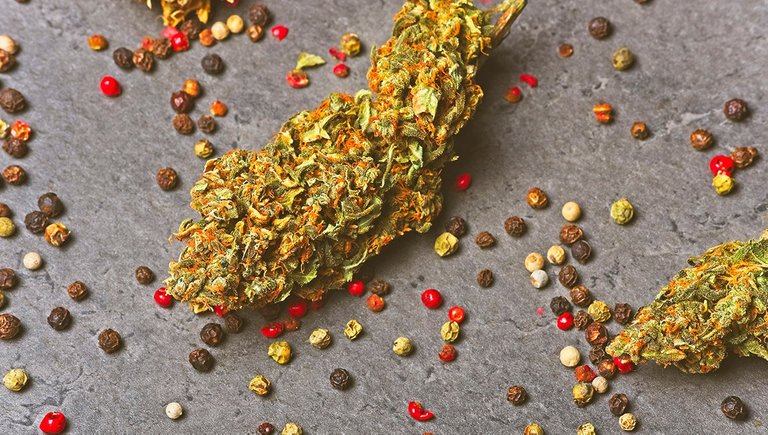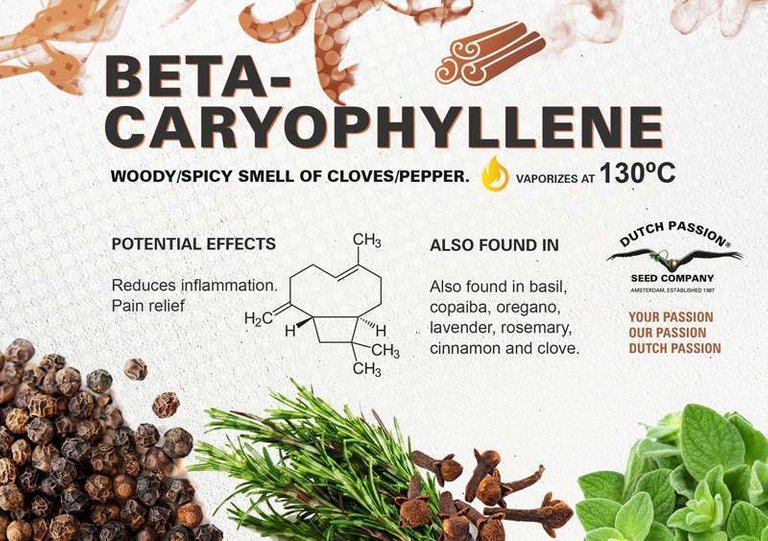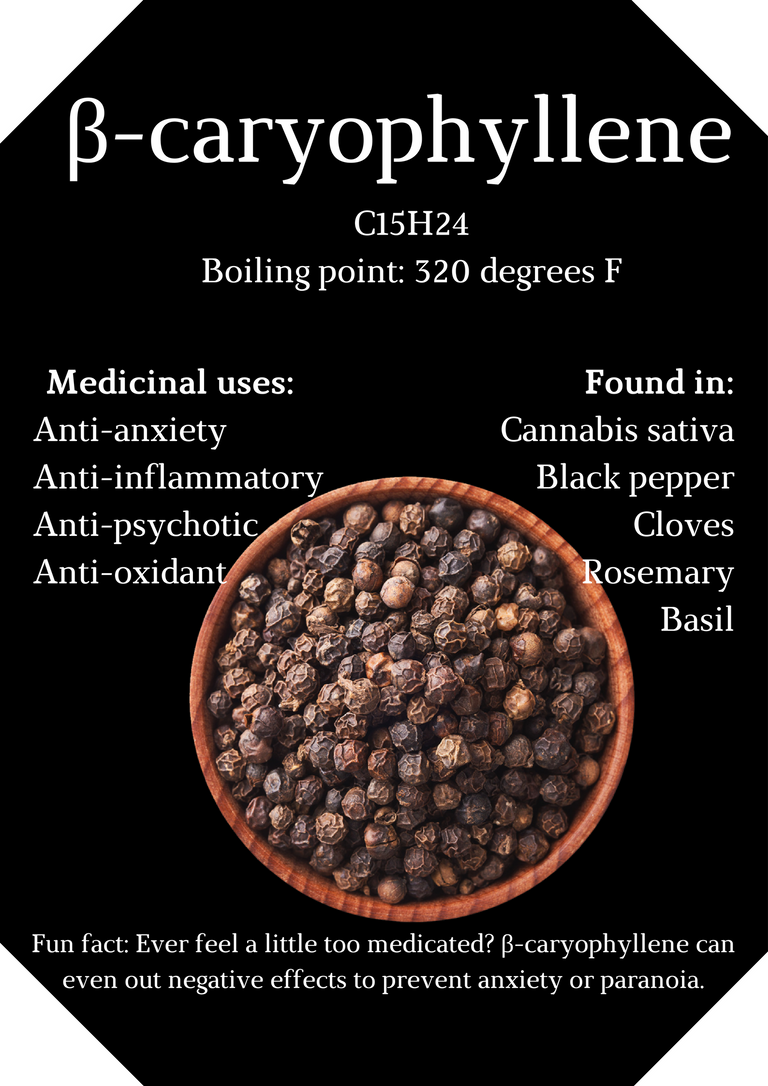Terpene Series: Caryophyllene // Série Terpenos: Cariofileno
After a long break, we returned to the study of terpenes. I hope everyone had a great end of the year and a great start to the year. Today I'm going to talk about a terpene that I really like. Caryophyllene, also called Beta Caryophyllene, is quite common in cannabis (and in all of nature) and has a spicy and woody odor. The place where it is classically most present is in black pepper, cinnamon, copaiba oil (probably the biggest source of B-caryophyllene in nature), but also in various cannabis strains, such as Skywalker and Sourdiesel.

Source
Perhaps the most fascinating role of Caryophyllene is its close relationship with CB2 receptors, the same receptor as CBD. It binds to the receptor and enhances its uptake, which makes its presence in cannabis very welcome, helping to intensify the herb's therapeutic qualities. Caryophyllene has been studied in medicine since the 1960s and is one of the most scientifically known natural terpenes. Likewise, it is as popular as in cooking, used in spices since the beginning and also in the production of beverages, from beers (very present in hops) to some spirits.

Source
Like most terpenes, Beta Caryophyllene has an intense anti-inflammatory potential. Some laboratory tests with rats have already proven its potential to cure arthritis, for example. But this can be taken to much more practical levels, when we think about the healing potential of copaiba oil, for example, when used on wounds. Some studies also claim that Caryophyllene is able to reduce the growth of some types of cancer. When synergized with other terpenes, caryophyllene has great beneficial effects in aiding sleep as well. Its relationship with the CB2 receptor even guarantees an intense potential against anxiety, similar to the potential of CBD or even a low dose of clonazepam. And finally, its presence in flowers ensures that the chosen genetics are very good against pain.

Source
Finally, an interesting curiosity: Have you ever heard that pepper helps "get over the highs"? This is exactly due to the high presence of Beta Caryophyllene, which has an immense potential to organize the unregulated experience, increasing the signals of CB2 and leaving the person more relaxed, less tense and anxious and softening the force of the trip that is harming him at the moment. . The use of Copaíba oil, black pepper or even CBD can be a strategy to avoid "traveling too much".
Research sources for this article:
1, 2, 3 and 4
Terpene series:
Limonene
Pinene
Myrcene
Introduce Terpene Series
Cannabinoid series:
THCV
CBG
THCA
Canabinnoids introduction
Thômas Helon Blum

Português
Depois de uma longa pausa, voltamos ao estudo dos terpenos. Espero que todos tenham tido um ótimo fim de ano e um ótimo começo de ano. Hoje irei falar sobre um terpeno que gosto muito. O Cariofileno, também chamado de Beta Cariofileno, bastante comum na cannabis (e em toda a natureza) e que traz um odor picante e amadeirado. O local onde ele é classicamente mais presente é na pimenta preta, na canela, no óleo de copaíba (provavelmente a maior fonte de B-Cariofileno da natureza), mas também em várias strains de cannabis, como por exemplo na Skywalker e na Sourdiesel.

Source
Talvez o papel mais fascinante do Cariofileno é sua estreita relação com os receptores CB2, o mesmo receptor do CBD. Ele se vincula ao receptor e potencializa sua captação, o que torna sua presença na cannabis muito bem vinda, ajudando a intensificar as qualidades terapeuticas da erva. O cariofileno é estudado na medicina desde 1960 e é um dos terpenos naturais mais conhecidos cientificamente. Da mesma forma é tão popular quanto na culinária, utilizada nas especiarias desde sempre e também na produção de bebidas, desde cervejas (muito presente no lúpulo) até em alguns destilados.

Source
Tal qual a maioria dos terpenos, o Beta Cariofileno tem intenso potencial de anti-inflamatório. Alguns testes laboratoriais com ratos já provaram seu potencial para curar artrite por exemplo. Mas isso pode ser levado a níveis muito mais práticos, quando pensamos no potencial curativo do óleo de copaíba por exemplo quando utilizado em ferimentos. Alguns estudos afirmam também que o Cariofileno é capaz de reduzir o crescimento de alguns tipos de cancer. Quando colocado em sinergia com outros terpenos, o cariofileno tem grandes efeitos benéficos para auxiliar no sono também. Sua relação com o receptor CB2 inclusive garante um intenso potencial contra a ansiedade, semelhante ao potencial do CBD ou mesmo de uma baixa dosagem de clonazepam. E por fim, sua presença nas flores garante que a genética escolhida é muito boa contra dores.

Source
Por fim uma curiosidade interessante: Já ouviu falar que pimenta ajuda a "passar a chapação"? Isso se dá exatamente pela alta presença de Beta Cariofileno, que tem um potencial imenso em organizar a experiência desregulada, aumentando os sinais de CB2 e deixando a pessoa mais relaxada, menos tensa e ansiosa e amenizando a força da viagem que lhe está prejudicando no momento. O uso de Oleo de Copaíba, Pimenta preta ou mesmo CBD pode ser uma estratégia para evitar "viajar demais".
Fontes de pesquisa desse artigo:
1, 2, 3 e 4
Terpene series:
Limonene
Pinene
Myrcene
Introduce Terpene Series
Cannabinoid series:
THCV
CBG
THCA
Canabinnoids introduction
Thats cool to know. I remember hearing back in the day that Sour D went great with opiates for pain relief
Indeed! This is a strain that I haven't tried yet, but one day I will!
Certainly part of this benefit comes from the B Caryophylenne itself! :)
You can view the daily or weekly curation report and earn weedcash from Delegation and help BURN some WEED